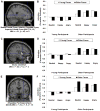Processing own-age vs. other-age faces: neuro-behavioral correlates and effects of emotion
- PMID: 23602923
- PMCID: PMC3684564
- DOI: 10.1016/j.neuroimage.2013.04.029
Processing own-age vs. other-age faces: neuro-behavioral correlates and effects of emotion
Abstract
Age constitutes a salient feature of a face and signals group membership. There is evidence of greater attention to and better memory for own-age than other-age faces. However, little is known about the neural and behavioral mechanisms underlying processing differences for own-age vs. other-age faces. Even less is known about the impact of emotion expressed in faces on such own-age effects. Using fMRI, the present study examined brain activity while young and older adult participants identified expressions of neutral, happy, and angry young and older faces. Across facial expressions, medial prefrontal cortex, insula, and (for older participants) amygdala showed greater activity to own-age than other-age faces. These own-age effects in ventral medial prefrontal cortex and insula held for neutral and happy faces, but not for angry faces. This novel and intriguing finding suggests that processing of negative facial emotions under some conditions overrides age-of-face effects.
Copyright © 2013 Elsevier Inc. All rights reserved.
Figures


References
-
- Ames DL, Jenkins AC, Banaji MR, Mitchell JP. Taking another person’s perspective increases self-referential neural processing. Psychol Sci. 2008;19:642–644. - PubMed
-
- Amodio DM, Frith CD. Meeting of minds: The medial frontal cortex and social cognition. Nat Rev Neurosci. 2006;7:268–277. - PubMed
-
- Anastasi JS, Rhodes MG. An own-age bias in face recognition for children and older adults. Psychon Bull Rev. 2005;12:1043–1047. - PubMed
-
- Bush G, Luu P, Posner MI. Cognitive and emotional influences in anterior cingulate cortex. Trends Cogn Sci. 2000;4:215–222. - PubMed
Publication types
MeSH terms
Grants and funding
LinkOut - more resources
Full Text Sources
Other Literature Sources

